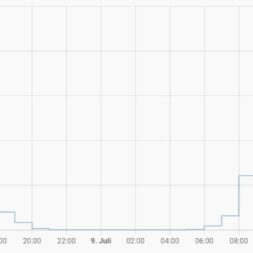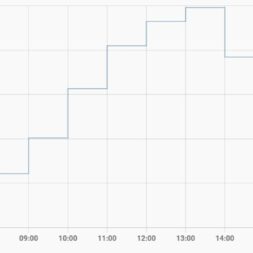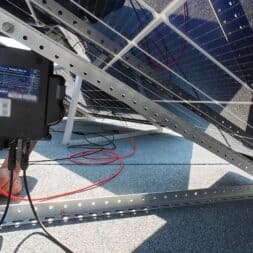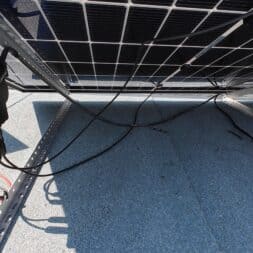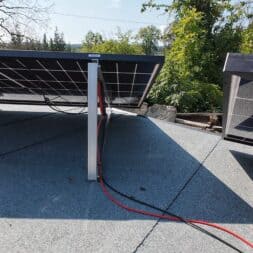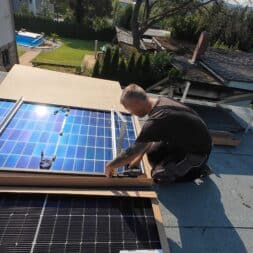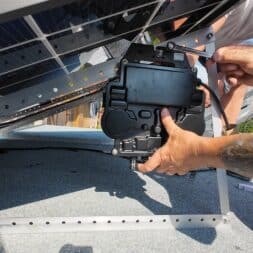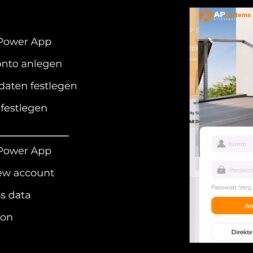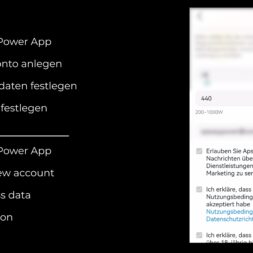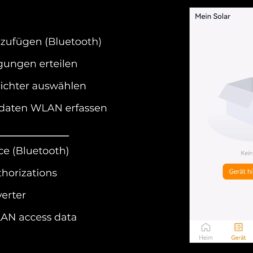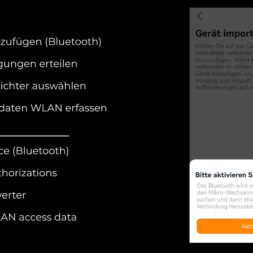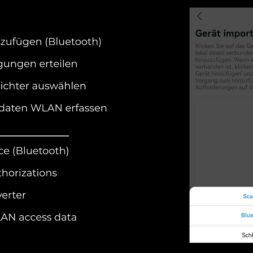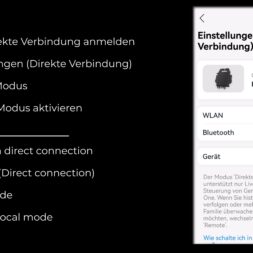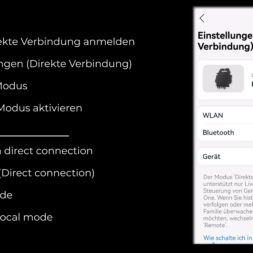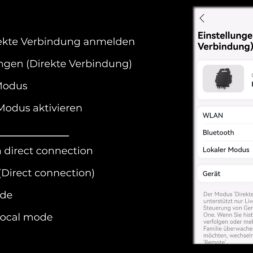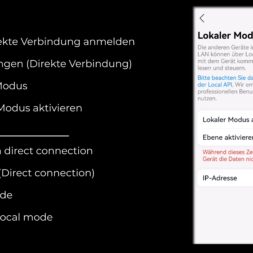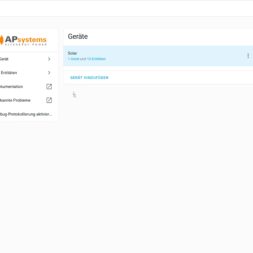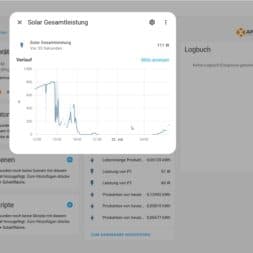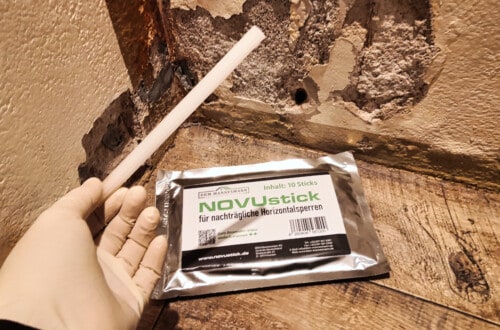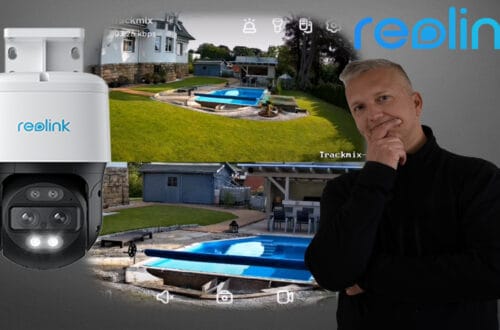
Optimize balcony power plant – New modules and 220V battery storage for maximum efficiency
In this blog post, I describe how I have optimized my balcony power plant to maximize self-consumption and reduce dependence on grid power.
I have installed new modules, improved the alignment and will integrate a battery storage system that supports bidirectional AC charging.
I go into detail about setting up the EasyPower app and integrating the new AP system EZ1 inverter into my Home Assistant for monitoring, as well as the results achieved and future plans to further increase efficiency.
The aim is to maximize the efficiency of my system and make the best use of the solar power generated.
Design and function of a balcony power plant
A balcony power plant usually consists of several PV modules that convert sunlight into direct current.
This direct current is converted by an inverter into 220V alternating current, which can be used directly in the household.
In my setup, I use two PV modules, each of which is equipped with its own micro inverter and has a maximum output power of 300W. Installation is relatively simple: the PV modules are mounted on the balcony or terrace and optimally aligned with the sun.
The inverter is connected to the socket via a simple earthed cable, which feeds the electricity generated into the household grid.
Electricity that is not currently being used is fed into the grid.
It is important to note that this feed-in is not remunerated.
It therefore makes sense to consume as much of the electricity generated as possible yourself in order to reduce your own energy costs. Another issue is the backstop on electricity meters.
Modern electricity meters prevent the meter from turning backwards when electricity is fed into the grid.
This ensures that the electricity fed into the grid is not registered as negative consumption.
To increase efficiency, surplus electricity can be temporarily stored in a battery storage unit and called up again when required.
This maximizes self-consumption and further reduces electricity costs.
For whom is a balcony power plant worthwhile?
A balcony power plant is particularly suitable for tenants and homeowners who do not have access to a large roof area.
It offers a simple way to cover part of your own electricity requirements with solar energy and thus reduce your electricity costs.
It also helps to reduce CO2 emissions and supports the energy transition.
Basic consumption of a house and an apartment
The basic consumption of an average household in Germany is around 2500 to 3500 kWh per year, while an apartment typically consumes 1500 to 2500 kWh.
The main consumers include household appliances such as refrigerators, washing machines, dishwashers and lighting.
Overview of average daily electricity consumption:
- Refrigerator: approx. 1 kWh/day
- Washing machine: approx. 0.5 kWh per wash cycle (with 4 washes per week approx. 0.3 kWh/day)
- Dishwasher: approx. 1.2 kWh per wash cycle (with daily use)
- 4-bay NAS: approx. 0.3 to 0.5 kWh/day
- PoE camera system with NVR and 4 cameras: approx. 0.8 to 1 kWh/day
In my household, there is also a 450W pool pump, an air conditioning system and other technical devices that increase electricity consumption.
Particularly in summer, when the pool pump and air conditioning are in frequent use, the energy demand increases considerably.
By expanding my balcony power plant and integrating a battery storage unit, I want to cover this additional consumption more efficiently and maximize my self-consumption.
Balancing counting method and phases in the electricity grid
Another important aspect of operating a balcony power plant is the balancing metering of the electricity meters.
In a typical household, electricity is distributed across several phases.
This means that different appliances can be operated on different phases.
Let’s assume that the balcony power station is connected to phase 1, while a large consumer such as a washing machine runs on phase 2.
In this case, the electricity generated by the balcony power station is not used directly for the washing machine.
However, thanks to the netting counting method of the electricity meter, the total electricity generated across all phases is taken into account.
This means that the surplus electricity from phase 1 can balance out the consumption on phase 2.
Example: The balcony power station generates 300W on phase 1, while the washing machine consumes 500W on phase 2.
The meter offsets the two values, which means that ultimately only 200W has to be drawn from the grid.
Only the actual 200W has to be paid for on the electricity bill.
Why the solar power generated still pays off Despite the phase distribution and the possibly different use in the household, the solar power generated pays off.
The netting counting method means that all the electricity generated is taken into account and offset against consumption.
This leads to an effective reduction in electricity costs, as less electricity has to be drawn from the grid.
The integration of a battery storage system can further enhance this effect by storing surplus electricity and using it at a later time when consumption is higher or solar radiation is insufficient.
Amortization period of a balcony power plant
A balcony power station with 300W output power costs around 250 euros.
Let’s assume that the balcony power station generates its maximum output for an average of 4 hours per day.
This results in a daily electricity production of 1.2 kWh (300W x 4h).
Calculated over the year (365 days), this results in a total production of: 1.2 kWh/day x 365 days = 438 kWh/year If the electricity price is €0.30 per kWh, this results in an annual saving of: 438 kWh x €0.30/kWh = €131.40/year This means that the balcony power station would pay for itself after around 1.9 years: 250 euros / 131.40 euros/year ≈ 1.9 years It should be noted that the yields in summer are significantly higher than in winter due to the longer duration of sunshine and higher solar radiation.
In summer, the balcony power plant can therefore cover a larger part of the daily electricity demand, while production is lower in winter.
Nevertheless, year-round use helps to reduce costs.

- :- 2x 440W Bifazial Glas-Glas Frame PV Modul, 1x HMS-800W-2T Upgradefhiger WIFI Mikrowechselrichter, 1x HMS Feldstecker, 1x 3 Meter + Schukostecker
- :- Bifaziale Solarmodule bieten den Vorteil, bis zu 30% mehr Energie im Vergleich zu traditionellen Modulen mit derselben Leistung zu erzeugen. Dies wird durch die Nutzung von Sonnenlicht auf beiden Seiten der Module (Glas-Glas) erreicht.
- :- Unbeugsam gegen die Krfte der Natur, widersteht es starken Winden (2400 Pa) und schweren Schneelasten (5400 Pa). Seine bifazialen Zellen, eingefasst in Glas auf beiden Seiten, gewhrleisten Langlebigkeit und verbesserten Schutz whrend Strmen oder widrigen Wetterbedingungen. TV-zertifiziert und PID-resistent, garantiert dieses Solarmodul maximale Effizienz und bietet eine 25-jhrige Produktgarantie sowie eine unschlagbare 30-jhrige Leistungsgarantie (87,4% Leistungsgarantie).
- - HMS: HMS Wechselrichter sind bekannt fr ihre berlegene Qualitt und Zuverlssigkeit, die von billigen Alternativen unerreicht bleibt. Verbessern Sie Ihr Balkonkraftwerk Setup mit unserem HMS-800 Wechselrichter. Genieen Sie eine nahtlose Plug & Play-Installation und Wi-Fi-Konnektivitt fr Echtzeitberwachung ber S-Miles Cloud. Dieser HMS 800 Wechselrichter ist von 600W auf 800W aufrstbar, sodass Sie stets an der Spitze der Technologie stehen. Mit 12 Jahren Garantie und IP67-Schutz ist er die zuverlssige und effiziente Wahl.
- : Bei uns erhalten Sie garantierte Qualitt. Als vertrauenswrdiger Anbieter von Solurlsungen stehen wir fr Zuverlssigkeit und bieten Produkte, die fr nachhaltige und sorgenfreie Energie garantiert sind. Unsere engagierten Support-Teammitglieder stehen Ihnen zur Verfgung, um Ihre Fragen zu beantworten und Probleme im Zusammenhang mit Ihrem Kauf zu lsen.
- (*) : Die Watt-Zahl eines Solarpanels gibt die maximale Leistung an, die das Panel unter idealen Bedingungen generieren kann. Sie dient als Mastab fr die Energieproduktion des Panels und ermglicht es, die Leistungsfhigkeit verschiedener Panels zu vergleichen. Ein hherer Watt-Wert zeigt generell eine hhere Energieausbeute des Panels an.
Optimize balcony power plant and self-consumption
In order to optimize and increase the yield of a balcony power plant, there are several basic measures that can both increase the efficiency of the system and maximize self-consumption.
Yield optimization
Optimal alignment and inclination: The PV modules should be optimally aligned to the sun and mounted at a suitable tilt angle to make the best possible use of solar radiation.
In Germany, a south-facing orientation and an inclination angle of around 30 to 35 degrees is ideal.
For example, adjustable brackets can be used to optimally align the modules depending on the season.
Avoid shading: Any shading from trees, buildings or other obstructions should be avoided as shade can significantly reduce the performance of the modules.
Regular pruning of trees and strategic placement of the modules will help to minimize this effect.
An example would be to mount the modules on a freestanding structure to ensure that they receive unobstructed sunlight throughout the day.
Regular cleaning: Dust, leaves and other debris can affect the efficiency of PV modules.
Regular cleaning of the modules ensures that they can always capture the maximum amount of sunlight.
A simple example is regularly spraying the modules with a garden hose to remove dust and dirt.
Use high quality components: Using high-quality inverters and other components can increase the efficiency of the system and ensure the longevity of the entire installation.
A high-efficiency inverter converts more direct current into usable alternating current, which increases overall efficiency.
Optimization of self-consumption
Load management: The use of household appliances such as dishwashers, pool pumps and air conditioning should be coordinated with times of high solar power production.
This can be achieved using programmable timers or smart home systems.
For example, the dishwasher could be programmed to switch on automatically when the sun is at its strongest.
However, there are limits to load management: a washing machine has to be unloaded after washing.
If no one is at home during the day, this does not work, which is why appliances such as the dishwasher or the pool pump are more suitable.
Integrate energy storage: Installing a battery storage system allows you to store surplus electricity that is produced during the day but not used immediately.
This electricity can then be used in the evening and at night to increase self-consumption.
For example, a battery can store solar power generated during the day and then use it to power lighting and other electrical appliances in the evening.
Monitor energy consumption: The use of monitoring tools and energy management systems helps to monitor and adjust energy consumption in the home.
This allows consumers to be identified and used specifically at times of high solar production.
An example would be the use of smart sockets that display real-time consumption and make recommendations for shifting consumption.
Use efficient appliances: Replacing old, energy-intensive appliances with modern, energy-efficient models can reduce electricity consumption and increase the proportion of solar power you use yourself.
For example, modern LED lamps consume significantly less electricity than conventional light bulbs, which makes self-consumption of solar power more efficient.
I am planning to extend my existing balcony power plant with two additional modules and integrate a battery with intelligent management and zero feed-in.
The new modules will give me maximum solar radiation throughout the day. A new integrated battery storage system will allow me to store excess electricity and use it when needed, which will maximize my self-consumption.
I plan to connect the storage system on the AC side, i.e. to a normal socket in the house.
With the intelligent control system, I can ensure that the electricity generated is used efficiently and that no surpluses are fed into the grid that are not remunerated.
These measures should help to significantly reduce my electricity costs and increase my independence from external power sources.
In this way, I can not only generate electricity in an environmentally friendly way, but also enjoy long-term financial benefits.
Zuletzt aktualisiert am 21. November 2024 um 03:00 . Ich weise darauf hin, dass sich hier angezeigte Preise inzwischen geändert haben können. Alle Angaben ohne Gewähr. (*) Bei den verwendeten Produktlinks handelt es sich um Affiliate Links. Ich bin nicht der Verkäufer des Produktes. Als Amazon-Partner verdiene ich an qualifizierten Verkäufen. Dein Preis ändert sich jedoch nicht.
Solar power peaks at midday, shortage in the evening: current yield situation
So far, I have installed two modules on the new timber-framed roof of my garden terrace.
These two modules are each equipped with their own inverter, which offers a maximum output power of 300W.
The modules face south-south-east (SSO) and south-south-west (SSW), which gives me the highest yield from late morning to early afternoon.
I have placed the consumption of my large electricity consumers as far as possible in this time.
However, as I often work from home in my home office, I lack the balance of solar power in the early morning and in the evening, when the family generates higher electricity consumption at the end of the working day. Thanks to the smart radio-controlled socket, I can read out the electricity production data and evaluate it in my Home Assistant.
This gives me a good overview of the production curve throughout the day:
- Early morning: On cloudless days, the total electricity production of both modules exceeds 50W from around 08:00.
- Morning: 200W are produced from around 10:00 a.m., which covers a large part of my base load in the house.
- Midday: Between 12:00 and 14:00, the electricity yield reaches its peak with a peak of approx. 500W.
- Afternoon: From 14:00, the yield drops sharply.
Between 16:00 and 17:00 it drops from around 250W to less than 50W.
The distribution of the yield curve resembles a sine curve, but is very steep.
This means that electricity production rises quickly in the morning, peaks around midday and falls sharply again in the afternoon.
During this midday period, I often have a surplus of solar power, some of which remains unused.
This surplus does not benefit me, as the unused electricity is fed into the grid without me receiving any remuneration for it. The main problem is that I don’t have enough solar power in the morning and evening.
In the morning, production is not yet sufficient to cover demand, and in the evening, when the family comes home and electricity consumption increases, production has already dropped again.
The unused surplus at lunchtime can therefore not be put to good use and does not help me to compensate for the lack of energy at the times I need it. To solve this problem, I plan to install an additional balcony power plant with two more modules.
The four modules will face south-east (SE), south-south-east (SSE), south-south-west (SSW) and south-west (SW).
This means that electricity production will be better distributed throughout the day.
With this wider positioning of the modules, the sine curve of electricity production is broadened so that sufficient electricity is also produced in the morning and evening hours.
This should help to compensate for the lack of solar power at these times and maximize self-consumption.



Video: Extension of my balcony power plant for maximum efficiency!
I have summarized the expansion of my existing balcony power plant (BKW) in an informative video and published it on my YouTube channel.
In the video I show in detail the components, the installation and the setup for WLAN and app of my new extended balcony power plant. You can find more exciting videos on my YouTube channel or directly in the corresponding playlist.
-
Price: € 12.99instead of: € 13.99
-
Price: € 8.99instead of: € 19.49
-
Price: € 229.99instead of: € 244.85
-
Price: € 105.00instead of: € 127.99
Parts and components of the new balcony power plant
A balcony power plant (BKW) consists of several important components that work together to generate solar power and feed it into the household grid.
The individual components are listed below, their functions are described and information is given on what to look out for when purchasing.
PV modules
Function: The PV modules are the heart of the balcony power plant.
They convert sunlight into direct current.
Technical data:
- Model: JA Solar JAM54D40 (Type N)
- Power: 445W per module
- Type: Bifacial (generates electricity on the front and back)
Type N: This type N refers to the N-type silicon technology used in the solar cells.
N-type solar cells have a higher efficiency and a longer lifespan than conventional P-type cells.
They are less susceptible to light-induced degradation (LID) and offer better performance at higher temperatures.
Bifacial: Bifacial modules are able to utilize sunlight from both the front and the back.
This enables higher power generation as reflected light from surfaces such as the ground or walls is also utilized.
Especially in environments with high reflection or when the modules are slightly inclined, the output can be significantly increased.
Bifacial modules can achieve an increase in output of up to 30% compared to conventional monofacial modules.
What to look out for: When buying, pay attention to the output (watts), size and efficiency of the modules.
Modules with a higher efficiency generate more electricity on a smaller surface area.
In addition, bifacial modules that can generate electricity on both the front and back are a good choice.
Inverter
Function: The inverter converts the direct current generated by the PV modules into 220V alternating current that can be used in the household.
The electricity generated can be consumed directly or fed into the grid to maximize self-consumption during the day.
At night, when there is no solar production, electricity is drawn from the grid or from an optional battery storage unit.
Technical data:
- Model: APSystems EZ1
- Power: 800W
App from EasyPower or AP Systems: The app offers a user-friendly interface for monitoring and controlling the inverter.
Users can monitor the energy yield, self-consumption and grid feed-in in real time.
The app also enables the analysis of historical data to optimize the efficiency of the balcony power plant.
Open API and smart home integration: The inverter can be operated in local mode and offers an open API.
This enables integration into smart home environments such as Home Assistant.
This allows the balcony power plant to be seamlessly integrated into the existing home automation system and controlled efficiently.
VDE-AR-N 4105:2018: This standard describes the technical connection rules for generation systems on the low-voltage grid.
It ensures that systems such as PV systems are operated safely and in a way that is compatible with the public grid.
Compliance with this standard is important for grid stability and grid safety.
The APSystems EZ1 inverter also complies with VDE-AR-N 4105:2018, which confirms its conformity with the current technical standards and legal requirements.
What to look out for: When purchasing an inverter, attention should be paid to the efficiency and maximum output power.
High efficiency ensures minimal energy losses during conversion.
It is also important to choose an inverter that is compatible with the output of the PV modules and meets the relevant standards.
Brackets and mounting systems
Function: The brackets and mounting systems are used to securely fasten the PV modules to the balcony, terrace or roof.
Technical data:
- Material: Aluminum
- Type: Flat roof elevation
- Size: 118 cm Set for 2 solar panels
What to look out for: Choosing the right bracket depends on the type of roof and the installation location.
For tiled roofs, special brackets are required to securely fasten the modules without damaging the tiles.
Corrugated metal roofs also require specific mounting systems that are suitable for the structure of the roof.
For flat roofs, like the one I have, an elevation offers the best solution.
My elevation consists of two long and one short aluminum profile (L-shape) that are screwed together in a triangular shape.
This allows me to set the angle of the elevation between 0° and 90°.
This offers the advantage of optimally aligning the modules depending on the time of year and solar radiation in order to achieve maximum electricity production.
Aluminum makes sense here as it is lightweight, corrosion-resistant and durable.
Cabling and connections
Function: The cabling connects the PV modules to the inverter and the inverter to the household grid.
Technical data:
- Extension cable: 2x 1.0m
- Cable to socket outlet: 1x 10m
- Additional cable: 3m cable for connecting the PV modules to the inverter with MC4 connectors
What to look out for: When buying, pay attention to the length and quality of the cable.
Cables should be UV-resistant and suitable for outdoor use.
The connections should be tight and secure to minimize energy loss.
With the additional 3m cable, I can position the modules optimally without a cable that is too short getting in the way.
This cable is equipped with MC4 connectors and can be connected to the existing cables from the module.
Monitoring systems and smart home integration
Function: Monitoring systems and smart home integration enable the balcony power plant to be monitored and controlled in real time.
This helps to optimize energy consumption and maximize the efficiency of the system.
Home Assistant: Home Assistant is an open source platform for home automation.
It enables the integration and control of various smart home devices and services via a central user interface.
Home Assistant can be downloaded for free from the official website and installed on a wide range of devices.
My installation: I use Home Assistant on a Fujitsu Esprimo Q920 with an Intel Quad Core i5 processor, 16GB RAM and a 512GB SSD.
This powerful system provides enough capacity to manage and monitor my entire smart home system.
Tapo P110: I use Tapo P110 smart sockets to monitor power consumption.
These sockets are equipped with Wi-Fi and can be controlled via the Tapo app.
With the Tapo integration in Home Assistant, I have connected the sockets to monitor and control energy consumption in real time.
The integration provides entities such as power consumption, power consumption and switching status.
Battery storage (future)
Function: A battery storage system makes it possible to store surplus electricity that is produced during the day but not consumed immediately.
This electricity can then be used when needed, e.g. in the evening.
Planning: I am planning to expand my existing balcony power plant with a battery storage system that can be charged bidirectionally on the AC side.
The Zendure Hyper 2000 is an interesting option for this.
Unlike many other battery storage systems, the modules do not have to be connected directly. The battery can be connected to a socket anywhere in the household grid.
Charging is still carried out by the PV modules, which feed into the domestic grid elsewhere. So I only need two sockets.
The Hyper 2000 also offers automatic load management in conjunction with a Shelly EM3.
This system enables efficient control and optimization of electricity consumption in the household.
Summary of the components
- PV modules: JA Solar JAM54D40 (type N), 445W per module, bifacial.
- Inverter: APSystems EZ1, 800W, supports self-consumption and night mode, open API for smart home integration, complies with VDE-AR-N 4105:2018.
- Brackets and mounting systems: Aluminum, flat roof elevation, 118 cm set.
- Cabling and connections: 2x 1.0m extension cable, 1x 10m cable to the socket, 3m cable with MC4 plugs.
- Monitoring systems and smart home integration: monitor and control the balcony power station.
- Battery storage (future): Zendure Hyper 2000 as an option for future integration.
These components work together to ensure efficient and reliable solar power production.
When purchasing, it is important to pay attention to the quality and compatibility of the individual parts in order to get the best possible performance from the balcony power plant.

- % - Mit unserem neuestem 800W Wechselrichter steigern Sie ab sofort den Ertrag Ihrer PV Module um 33%. Profitieren Sie noch heute mit Ihrem Balkonkraftwerk!
- - Durch die bifazialen Solarmodule knnen Sie bis zu 30% mehr Energie erzeugen, bei gleicher Wattzahl. Die Technologie ermglicht es, Sonnenlicht auf beiden Seiten der Module (Glas-Glas) zu nutzen.
- - Das 1000W Balkonkraftwerk besteht nur aus hochwertigen Bauteilen. 2x Bifaziale 500W Jolywood HD120N Solarmodule, 1x Growatt 800W Wechselrichter, 2x 1,0m Verlngerungskabel, 1x 5m Kabel zur Steckdose & 1x Wechselrichterhalterung.
- - Mit der Telefon-App berwachen Sie Wechselrichter-Daten per WLAN-Funktion in Echtzeit. Sie sind direkt informiert ber tgliche & jhrliche Solarertrge & CO-Einsparungen! Dank einfacher Einrichtung und intuitiver Bedienung direkt startklar!
- - Die Bauteile der Stecker Solaranlage versprechen eine lineare Leistung bis zu 30 Jahre nach dem Kauf. Somit sind die Ertrge Ihres Balkonkraftwerks gesichert und bereit fr die Zukunft.
Installation of the balcony power plant
Assembling the profiles and installing the modules
First, I assembled the profiles of the elevation.
The construction consists of two long and one short aluminum profile, which are screwed together in a triangular shape.
The pre-drilled holes in the PV modules match the long holes in the profiles perfectly, which makes installation easier.
After the profiles were mounted, I set up the new modules and aligned them to the south-south-east (SSO) and south-south-west (SSW).
I aligned the two modules of my old balcony power plant to the south-east (SE) and south-west (SW).
It is important to avoid shadows cast by trees and the other modules, as shadows can significantly affect the performance of the modules.
I screwed the elevation of the modules directly to my roof.
I prepared the substructure of the roof for the installation of the modules during construction to ensure storm-proof fastening.
A storm-proof screw connection is important to hold the modules securely in strong winds or storms and prevent damage.
Connection of the inverter
After the modules were installed, I attached the inverter to the mounting bracket of one of the new modules.
The appropriate screw was included in the scope of delivery; alternatively, it would have been possible to mount it on the module using the enclosed module clamp.
I plugged the cables of the plus and minus poles of the first module into input 1 of the inverter.
The MC4 plugs have a male and a female connection, so there is no risk of confusion when plugging them in.
I extended the cables of the second module with an extension cable and plugged them into input 2 of the inverter.
The cables were fixed to the mounting bracket with cable ties.
Electrical connection and commissioning
I have plugged the earthed plug of the inverter into the socket.
The connecting cable for the balcony power station is a 3×2.5m² NYM cable, which is protected by an additional fuse in the distribution box.
After plugging in the safety plug, the inverter synchronizes itself with the power grid.
Synchronization of the inverter: Synchronization means that the inverter adjusts itself to the grid frequency and voltage of the power grid.
This is important to ensure that the electricity fed in is in line with the grid current and does not cause any grid interference.
As soon as synchronization is complete, the direct current from the PV modules in the inverter is transformed to 220V alternating current and fed into the household grid via the socket.

- [Witterungsbeständig] Unsere witterungsbeständigen, aus AL6005-T5 Aluminium gefertigten verstellbaren PV-Anlagen-Halterungen sind ganz einfach an dem Solarmodul anzubringen, sodass Ihre Solaranlage im Nu einsatzbereit, ist
- [Alles Dabei] Schrauben und Muttern aus Edelstahl SUS304 befinden sich bereits im Lieferumfang. Unsere verstellbaren Halterungen eignen sich für Aufbauten auf flachen Untergründen wie z.B. Garagen, Gärten, Balkone... .
- [Einfache Montage] Bequeme Justierung des Neigungswinkels, um den maximalen Ertrag zu ernten.
- [Details] Maße lange Strebe (BxTxH): 28 x 42x 3 mm Länge lange Strebe: 1180 mm Länge Querstrebe: 525 mm Maße Querstrebe (BxTxH): 28 x 32x 3 mm Max. Solarmodul breite: 1180 mm Materialstärke: 3 mm
- [Lieferumfang] 8x lange Streben 4x kurze Streben 2x Schrauben-Set
Setting up the monitoring app
The balcony power plant works and reliably feeds in solar power.
Monitoring the system makes sense and offers many advantages, such as monitoring energy production, detecting malfunctions and optimizing self-consumption.
In addition to the EasyPower app, I have also integrated it into my Home Assistant via the API interface.
Advantages of monitoring
- Monitor energy production: Thanks to real-time monitoring, I can see how much electricity my balcony power plant is generating at any time.
- Detect malfunctions: Any problems or failures can be quickly identified and rectified.
- Optimize self-consumption: With accurate data on electricity production, I can better adjust and optimize my energy consumption.
Setting up the EasyPower app
The EasyPower app makes it easy to monitor the inverter and PV modules.
- Download and install the app:
- Create new account: Create an account and define access data.
- Specify the location of the system: Specify the location of the balcony power plant.
- Add the device: Search for and select the inverter in the app via Bluetooth.
- Grant authorizations: Grant the app the necessary authorizations.
- Enter WLAN data: Enter access data for the WLAN to connect the inverter to the network.
Activate API in the inverter
To be able to use the API interface of the AP system EZ1 inverter, it must first be activated or enabled.
This is done by activating the local mode in the app.
To activate the function, a login with the “Direct connection” function must be selected in the app.
If a login with access data via the cloud is running, this function is missing.
- Log in to the app via “Direct connection” (log out of the cloud login beforehand if necessary).
- Device (select inverter)
- Select settings (direct connection)
- Select local mode – This menu item does not appear immediately but is loaded after a few seconds
- Activate local mode
A German user manual for the APSystems EZ1 inverter can be downloaded from APSystems.
As the API is provided via the local interface, i.e. the direct connection, I had to choose between the API and the cloud.
It is not possible to use both functions at the same time.
By the way, I have also described the app setup of the SolarMan app in great detail in the article 800W balcony power plant easy to install & optimize yourself.

- 【Highlights】Der APSystems EZ1-M 800W ist die speziell für Balkone und DIY-Systeme entwickelte Wi-Fi-Version der 3. Generation des DualMikrowechselrichters von APsystems. Er hat eine maximale Ausgangsleistung von 800 W und kann zwei PV-Module mit einer Eingangsleistung von 300-730Wp unterstützen.
- 【Doppelte Ausgangsleistung】Der EZ1-M verfügt über zwei Eingangskanäle mit unabhängigen MPPTs, damit optimiert der EZ1-M den Energieertrag Ihrer Solarmodule und beschleunigt die Investitionsrendite.Ein Wirkungsgrad von bis zu 97,3%, mit bis zu 799 VA (nach Upgrade) .
- 【Hochintegriert】Integriertes Wi-Fi und Bluetooth, verfolgen Sie Leistung und Status Ihrer Solaranlage überall auf Ihrem Mobiltelefon; Mit kompakten Abmessungen und integriertem VDE Relais; Einfache Integration: Der EZ1-M passt sich perfekt Hochleistungs-PV-Modulen mit hoher Eingangsstromstärke an.
- 【Technische Daten】Spitzenleistung MPPT des Spannungsbereichs: 28-45 V, Betriebsspannungsbereich: 16-60 V, Maximale Eingangsspannung: 60 V, Maximaler Eingangsstrom: 2x 20 A, Maximaler Eingangskurzschlussstrom: 2x 25 A, Nennausgangsleistung: 600 VA/ 799 VA, Nennausgangsspannung/-bereich: 230 V (184-253 V), Nennausgangsstrom: 2.6 A/ 3,5 A bei 230 V, Umgebungstemperaturbereich: -40 - +65°C
- 【Installation und Zuverlässigkeit】Einfache Montage direkt Solarmodul oder Montageprofil montiert werden. Der Anschluss erfolgt denkbar einfach mit Steckverbindung; Dank IP67-Gehäuse ist der EZ1-M für verschiedene Witterungsbedingungen gerüstet, wodurch Langlebigkeit gewährleistet wird.
- 【Konformität & Garantie】EN 62109-1/-2; EN 61000-6-1/-2/-3/-4; EN 50549-1; DIN V VDE V 0126-1-1; VFR; UTE C15-712-1; CEI 0-21; UNE 217002; NTS; RD647; VDE-AR-N 4105. Standardmäßig 12 Jahre-Garantie.
Setup in the Home Assistant
The integration of the balcony power station into the Home Assistant enables more comprehensive monitoring and automation.
- Home Assistant installation: Home Assistant is an open source home automation platform that can be downloaded for free from the official website.
I use Home Assistant on a Fujitsu Esprimo Q920 with an Intel Quad Core i5 processor, 16GB RAM and a 512GB SSD. - Use API interface: The inverter offers an open API that makes it possible to integrate data into the Home Assistant.
- Set up integration: In the Home Assistant settings, add the integration for the inverter and enter the API data.
- Tapo P110 smart sockets: I use Tapo P110 smart sockets to monitor power consumption.
These are integrated into Home Assistant via the Tapo app and provide entities such as power consumption, power consumption and switching status. - Configure dashboard: Create a dashboard in the Home Assistant to monitor and analyze the data from the PV modules, inverter and smart sockets in real time.

- Energieverbrauchskontrolle - Analysieren Sie den Echtzeit- und den historischen Stromverbrauch des angeschlossenen Geräts
- Einfache Einrichtung und Verwendung - Schnelle und einfache tägliche Einrichtung und Verwaltung über kostenlose App (kostenfrei für IOs und Android)
- Sprachsteuerung - Aktivieren Sie Ihre smarte Steckdose mit Sprachbefehlen über Amazon Alexa oder den Google Assistant
- Zugriff auch von unterwegs - Steuern Sie alle Geräte bequem über das Smartphone, überall und zu jeder Zeit
- Erstellen von Zeitplänen - Schalten Sie Ihre Geräte automatisch zu verschiedenen Zeiten an und aus
- Abwesenheitsmodus - Schalten Sie Ihre Lichter zu unterschiedlichsten Zeiten an und aus um die Anwesenheit einer Person zu simulieren
- Lieferumfang: Tapo P110 (nur auf 2.4GHz), Schnellinstallationsanleitung
- Die Größe des Produkts ist mit Stecker: 72 mm * 51 mm * 77 mm ohne Stecker 72 mm * 51 mm * 40 mm.
- Timer - Erstellen Sie zeitliche Pläne für angeschlossene Elektronik
Results of the optimization
Based on the electricity production of my old balcony power plant, I re-evaluated the data after expanding the modules and optimizing the alignment.
Early morning
- Power production: On cloudless days, the total power production exceeds 50W from around 06:30.
- Significance: Electricity production begins in the early hours of the morning, which helps to cover the base load early on.
Morning
- Electricity production: 200W are produced from approx. 08:00.
- Significance: A large part of the base load in the house is already covered in the morning, which reduces grid consumption.
Noon
- Electricity production: Between 10:30 and 16:30, the electricity yield reaches a broader peak of 800W.
- Significance: The increased and extended peak ensures that almost the entire daily consumption is covered by solar power during this time.
Afternoon
- Electricity production: From 16:30 onwards, the yield slowly decreases.
Between 18:30 and 17:30 it drops from around 250W to less than 50W. - Meaning: Production still covers part of the evening consumption before it drops to below 50W around 5:30 pm.
By extending and optimizing the alignment of the modules, electricity production has been improved throughout the day, which increases the coverage of the base load and optimizes self-consumption.
To further maximize self-consumption and reduce dependence on grid power, I am now implementing the integration of a Hyper 2000 battery storage system.
The Hyper 2000 enables a bidirectional charging function so that surplus solar power can be stored and fed back into the household grid when required.
I will share my experiences with the installation, use and increased self-sufficiency in one of my next blog posts.

- 【AC-gekoppelte Energiespeicherlösung】In einem einphasigen Stromkreis kann die Phase, in der Hyper 2000 installiert ist, durch die PLC-Kommunikation identifiziert werden, und bis zu drei Hyper 2000-Sets können installiert werden, ohne die Verkabelung zu ändern. Wenn drei Hyper 2000 installiert sind, können sie bis zu 5,4 kW Solareingang und 3,6 kW Ausgang (Ausgangsleistung einstellbar bis zu 800 W) unterstützen und auf eine maximale Kapazität von 23,04 kWh erweitert werden.
- 【Hybrid-Mikrowechselrichter】Hyper 2000 verfügt über ein Alles in einem Design, das einen Hub (intelligente Steuereinheit) und einen Mikro-Wechselrichter integriert, und unterstützt 1800 W Dual-MPPT-Eingang und 1200 W bidirektionale AC-Eingangs- und Ausgangs. (Ausgangsleistung einstellbar bis zu 800 W).
- 【Erweiterte Kostenoptimierung über TOU】Hyper 2000 verfügt über eine 1200W Wechselstrom-Lade- und Entladefunktion und integriert den Day-Ahead-Strompreis von Nord Pool in der Zendure APP. Benutzer können Lade- und Entladepläne basierend auf Strompreisschwankungen festlegen und die Preisdifferenz verdienen.
- 【Plug und Play】Der SolarFlow Hyper 2000 und das AB-Batteriepaket bilden ein modulares System, das auf 7,68 kWh skalierbar ist und in nur wenigen Minuten einfach installiert werden kann. Die Installation kann von Laien durchgeführt werden, sodass keine zusätzlichen Installationskosten anfallen.
- 【Intelligente Energieverwaltung】Zendure APP&Satellite Plug/Satellite Monitor CT, in der Anwendung können Sie den gesamten Verbindungsstatus, Energieerzeugung und -verbrauch sowie Batteriestatus des Balkon-Energiespeichersystems einsehen. Die Ausgangsleistung beträgt 0-1200W. Wenn die Ausgangsleistung 30W überschreitet, kann die Zendure APP die Ausgangsleistung mit einer Genauigkeit von 1W anpassen.
- 【Lieferumfang】Hyper 2000 *1, AB2000 *1, Montagezubehör, Deutsches Handbuch. Da viele Produkte enthalten sind, werden mehrere Pakete geliefert. Bitte warten Sie geduldig, bis mehrere Pakete eintreffen.
Summary and conclusion
This blog entry describes the structure and function of a balcony power plant, which consists of several PV modules that convert sunlight into direct current.
This is converted into 220V alternating current by an inverter and used directly in the household.
It explains how the PV modules are installed and aligned to achieve the best possible energy production.
Optimization and self-consumption: By expanding the balcony power plant and integrating a battery storage unit, self-consumption can be maximized and dependence on grid power reduced.
Zero feed-in ensures that surplus electricity is not fed into the grid unused.
Electricity production: Electricity production was analyzed at different times of the day.
In the morning, production of 50W is achieved from 06:30, in the morning 200W is produced from 08:00.
Midday offers a broad peak of 800W between 10:30 and 16:30.
In the afternoon, the yield slowly decreases from 16:30 and falls from around 250W to less than 50W between 16:30 and 17:30.
Balancing counting method: The importance of the netting metering method for electricity meters is discussed, which ensures that the solar power generated is used effectively despite different phase distribution in the household. This leads to a reduction in electricity costs, as all the electricity generated is taken into account.
Assembly and installation: It is described how the profiles of the elevation were screwed together, the modules mounted and the inverter connected. Important aspects such as avoiding shadows and storm-proof fastening are also explained.
Setting up the monitoring app and Home Assistant: Setting up the EasyPower app and integrating the balcony power station into Home Assistant are described in detail. This enables comprehensive monitoring and automation of the system.
Planned measures: For further optimization, the integration of a Hyper 2000 battery storage system is being implemented, which stores excess solar power and feeds it back into the domestic grid as required. The planned use of smart home integration with Home Assistant and Tapo P110 smart sockets for monitoring and control is also described.
Results and outlook: The measures implemented have significantly improved electricity production and self-consumption. Future blog posts will share detailed experiences with the installation, use and increased self-sufficiency.

- DOPPELSEITIGES PV-KABEL - Unser Kabel für Wechselrichter ist auf der einen Seite einer Betteri BC01 Female Buche & auf der anderen mit einem Wieland Steckverbinder Male RST2013 S ZR1 ausgestattet.
- HOCHWERTIG & SICHER ist das Betteri Kabel dank der Gummischlauchleitung, die für die Verwendung bei hohen Beanspruchungen, in trockenen & feuchten Räumen sowie im Freien & Nutzwasser zugelassen ist.
- KOMPATIBEL MIT APsystems, Hoymiles HM 300 / 350 / 400 / 700 / 1500 / 1800 / 1200 / HMT-2250-6T / HMT-1800-6T / Deye SUN600G3-EU-230 / SUN800G3-EU-230 / 1000G3- / TSUN M800(DE) / M800 / Tsol / Envertech, Huayu, Bosswerk & TSUN-TSOL & anderen Marken & Modellen.
- VERSCHIEDENE GRÖßEN - Neben der 5 Meter Länge ist unser robustes Avoltik Balkonkraftwerk Kabel auch in 10 m erhältlich - das ideale Zubehör für alle Ihre Photovoltaik-Projekte!
- AVOLTIK - Von der Photovoltaik Inselanlage bis hin zur Balkonkraftwerk Halterung - Wir bieten innovative & nachhaltige Lösungen in Top-Qualität sowie einen kundennahen Service.
Dieser Beitrag ist auch verfügbar auf:
English
Deutsch








